Step by Step Instructions (Field Calibration)
Purpose: Complete treatment plan analysis with calibration, dose mapping and plan comparison.
This example is based on single exposure calibration using a calibration field.
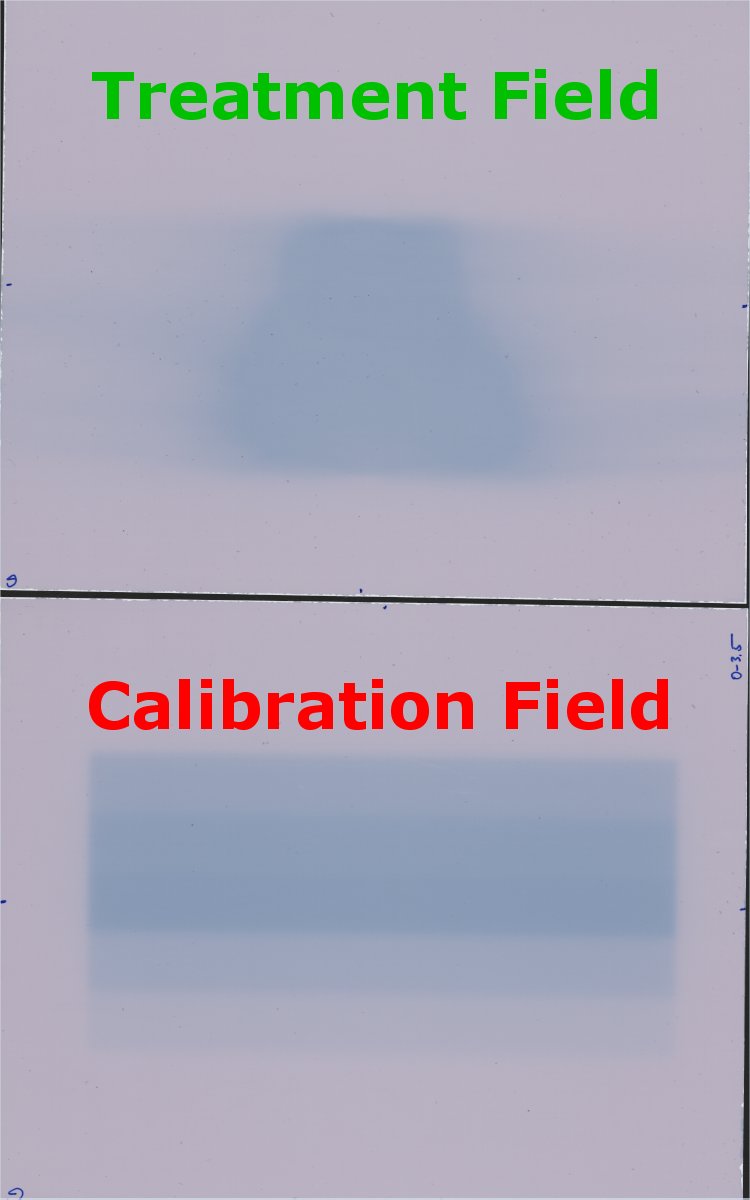
|
Protocol involves one image only!
Scanned image must include
-
Treatment field (treatment plan data are required).
-
Calibration field (calibration plan data are required).
Further calibration exposures (fields or strips) can be added.
|
Note: This are the recommended standard data for the OrthoChromic protocol.
Alternatively same treatment field example is available using
Data: Installation folder '.\Data\Example Prostate 250 cGy'.
|
1. Add Task
Add new task 'Treatment analysis' to the document.
Right click
 icon ('Landscape scan') and load bitmap 'Scan_Prostate 250 cGy StepWedge.tif'.
icon ('Landscape scan') and load bitmap 'Scan_Prostate 250 cGy StepWedge.tif'.
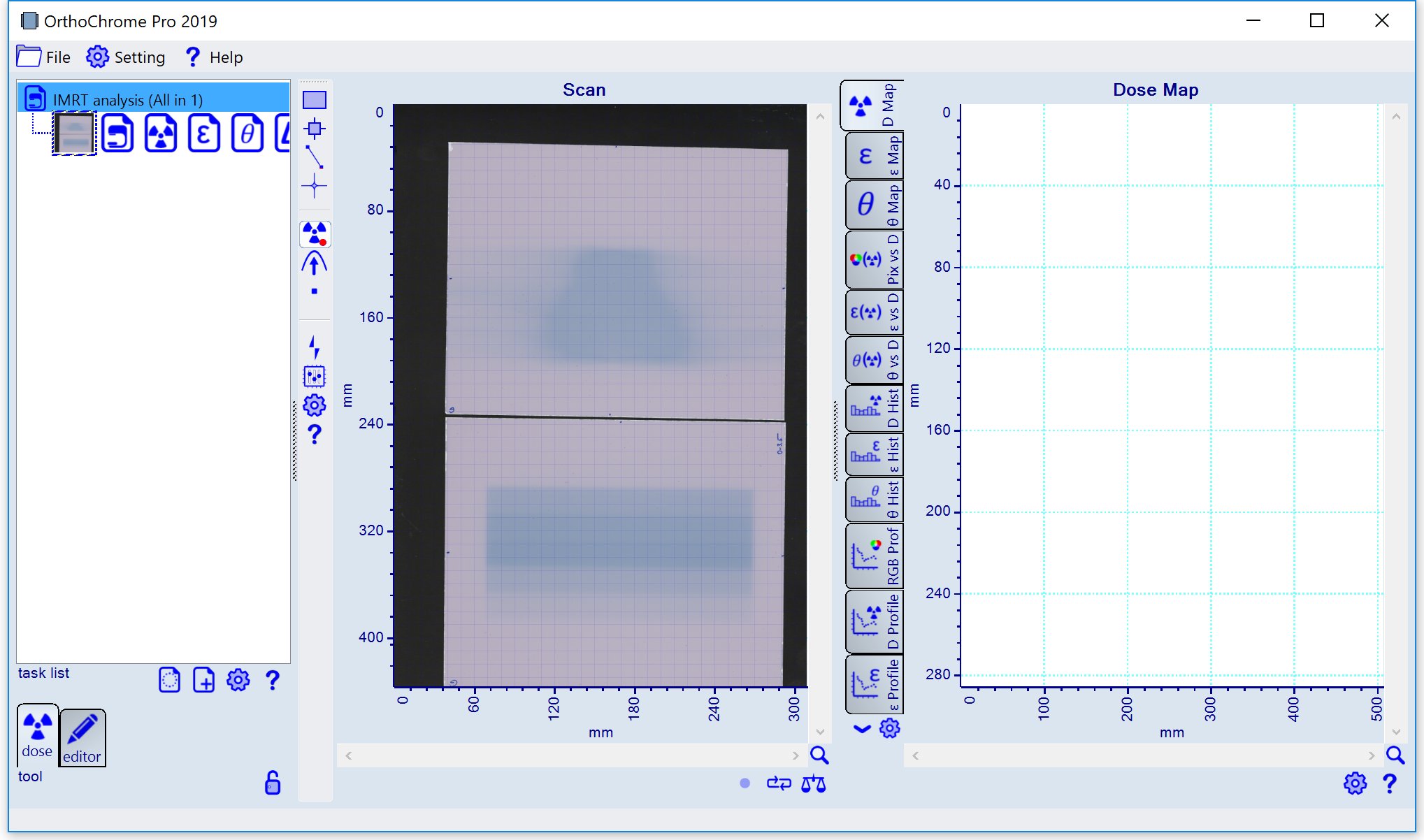
|
|
2. Calibration area
Select frame tool
 and draw frame around the step wedge calibration area as shown below.
and draw frame around the step wedge calibration area as shown below.
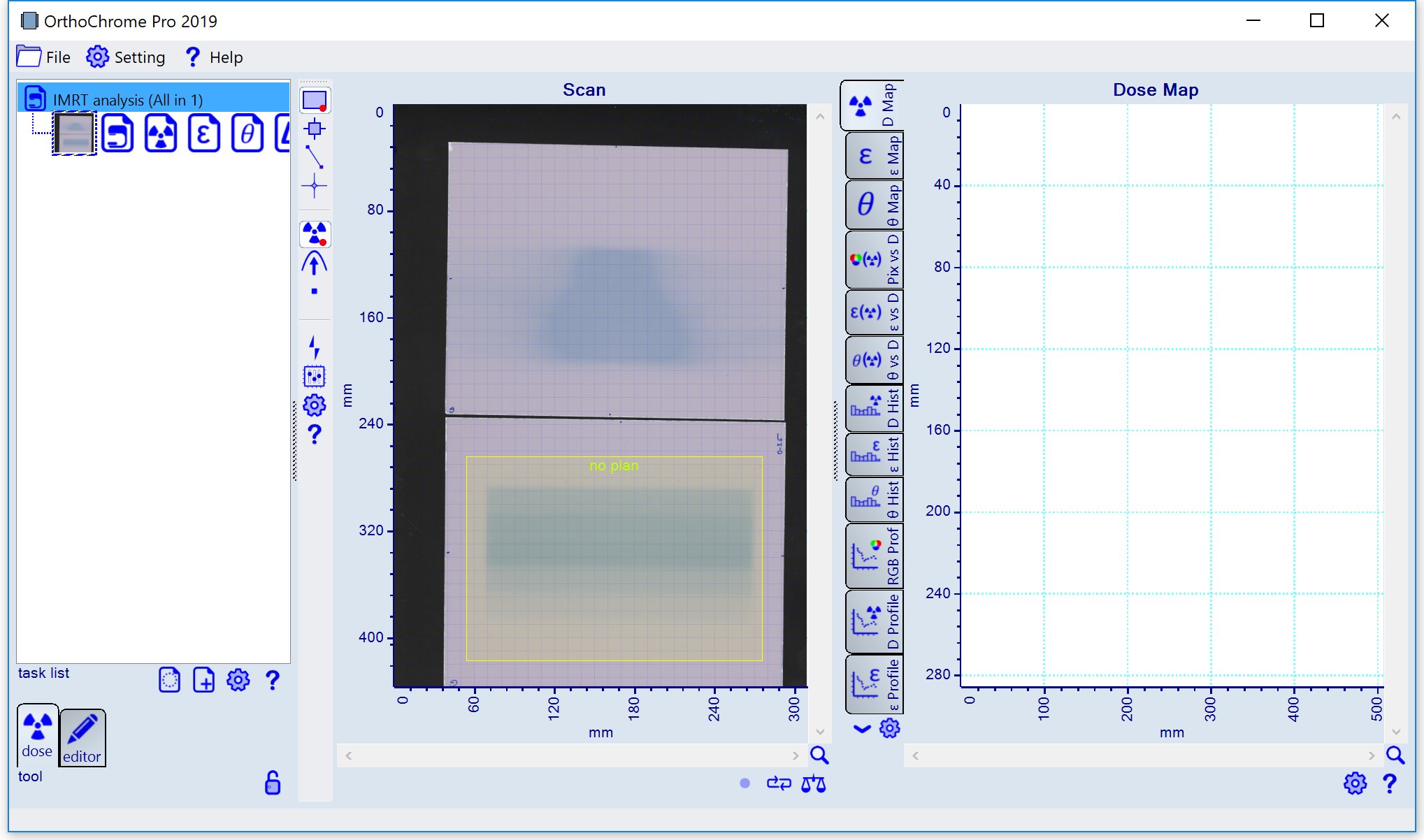
|
|
3. Assign calibration plan
Right click inside the drawn frame and select in the context menu 'Assign calibration plan'
 and load the plan data 'Prostate 250 cGy Step Calibration 0-3.5 Gy Dose Plane.dcm' (use the filter 'DICOM - dcm (single image)').
Note: The plan image needs to be rotated by 180° as shown below. Any quadrant adjustment (rotation, flipping), dose range scaling or cropping can be carried out in the 'Bitmap Reader' panel.
and load the plan data 'Prostate 250 cGy Step Calibration 0-3.5 Gy Dose Plane.dcm' (use the filter 'DICOM - dcm (single image)').
Note: The plan image needs to be rotated by 180° as shown below. Any quadrant adjustment (rotation, flipping), dose range scaling or cropping can be carried out in the 'Bitmap Reader' panel.
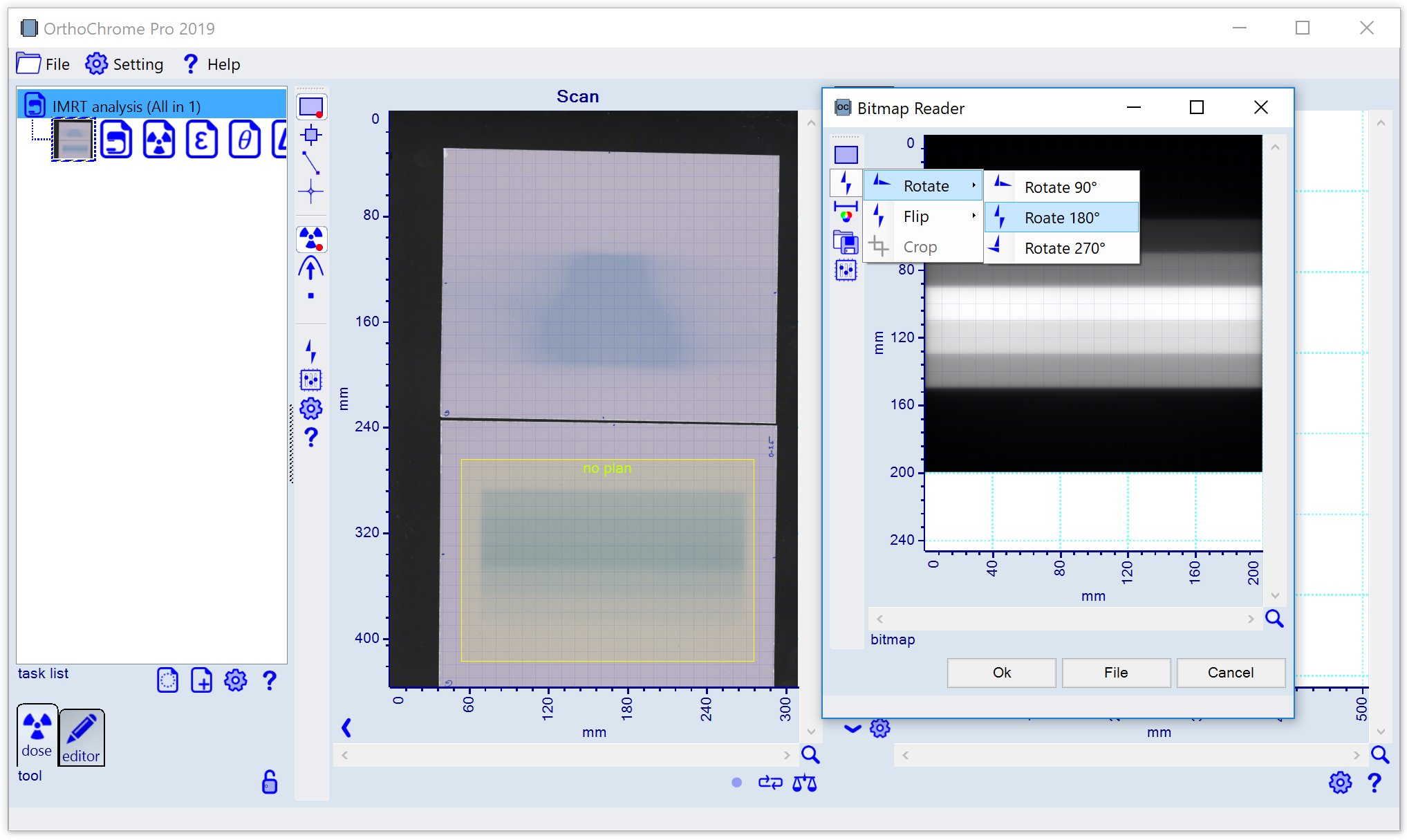
|
|
4. Calibration and Dose Map Generation
After the calibration plan is assigned, the calibration and dose map generation starts automatically (enabled by default) indicated by LED symbol
 underneath the center image. One can recalibrate at any time using the
underneath the center image. One can recalibrate at any time using the
 button.
To profile the calibration data vs calibration plan assign a predefine paths by right clicking inside the calibration frame as shown below.
button.
To profile the calibration data vs calibration plan assign a predefine paths by right clicking inside the calibration frame as shown below.
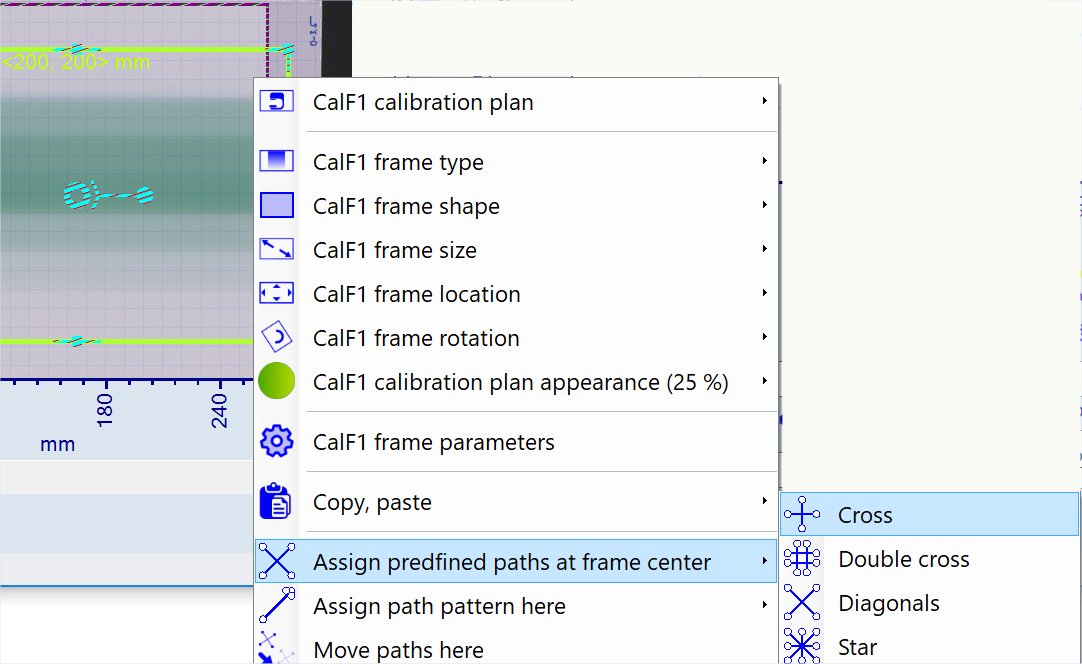 Select the 'Dose Profile' tab
Select the 'Dose Profile' tab
 of the chart mosaic to get the display as shown below indicating that the registration of the calibration plan is not perfect yet.
of the chart mosaic to get the display as shown below indicating that the registration of the calibration plan is not perfect yet.
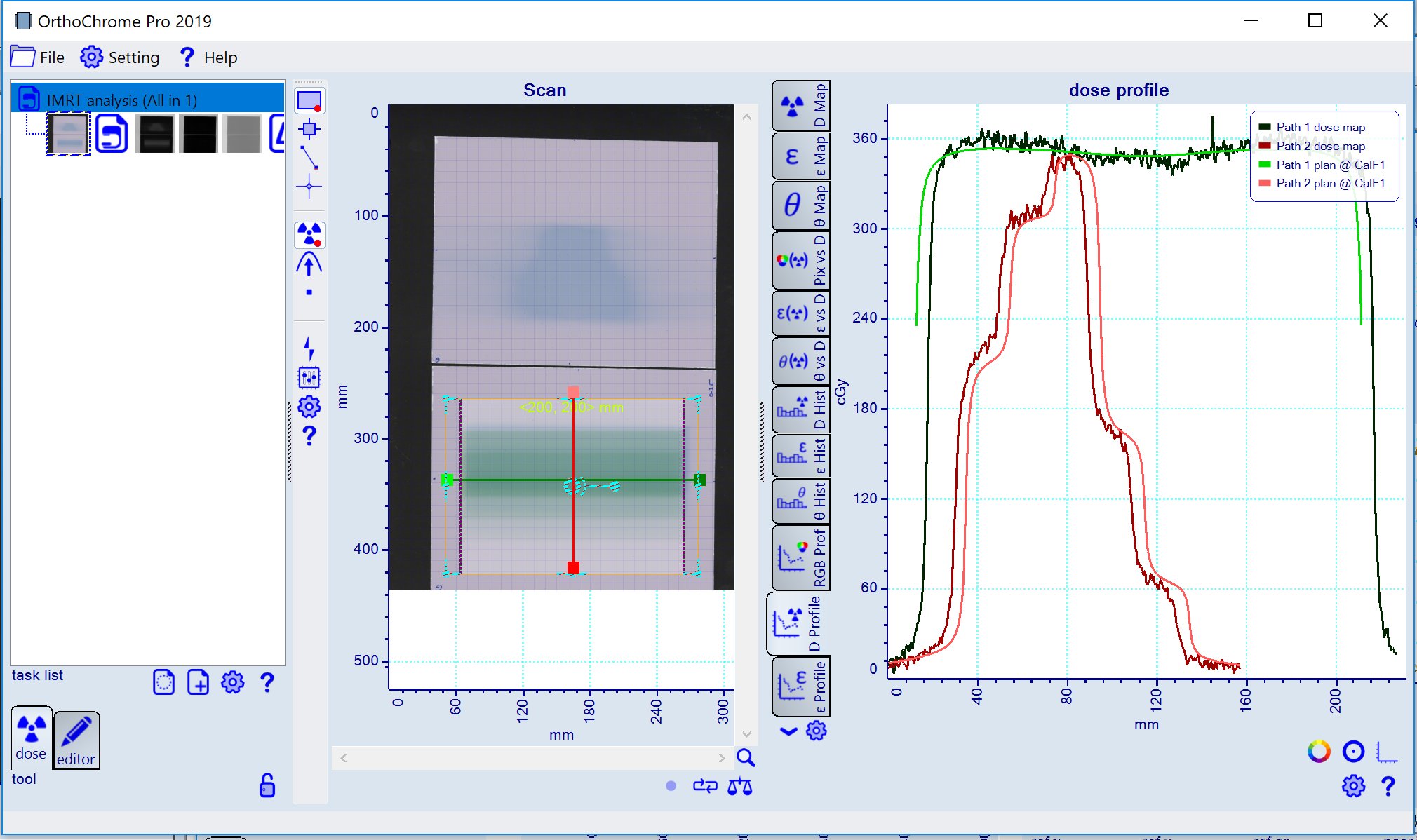
|
|
5. Optimization of calibration plan registration
Toggle from calibration mode
 to optimization
to optimization
 (selected icon carries red mark). The mosaic chart changs as shown below including now numerical fields for registration and comparison data.
(selected icon carries red mark). The mosaic chart changs as shown below including now numerical fields for registration and comparison data.
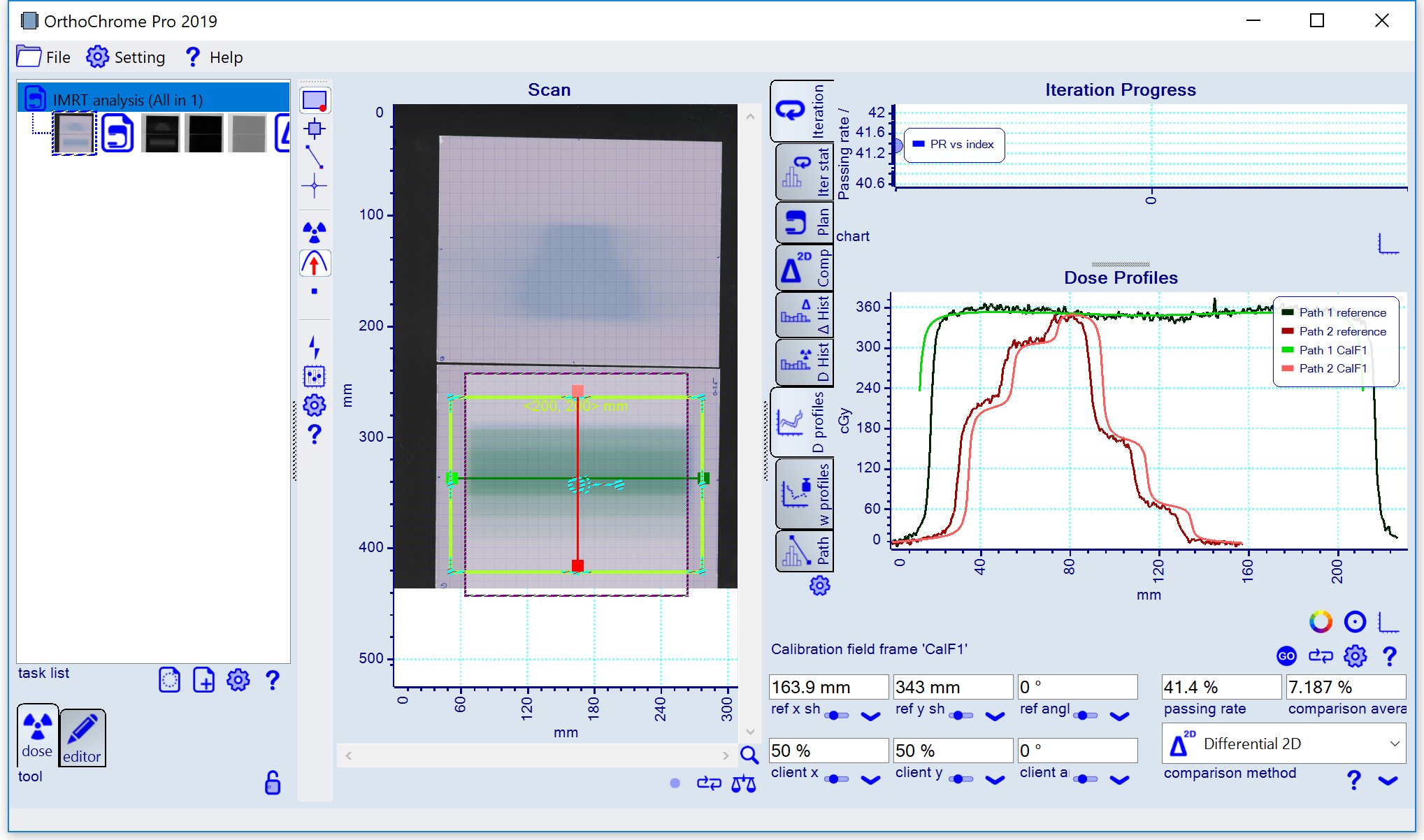
The 'comparison method' can be modified, e.g. to 'Gamma 2D' (use
 to modify comparison parameters).
To start the optimization of the calibration plan registration press the
to modify comparison parameters).
To start the optimization of the calibration plan registration press the
 button - below OC Pro panel with active optimization.
Note: The path locations can be modified during the optimization - activate path tool
button - below OC Pro panel with active optimization.
Note: The path locations can be modified during the optimization - activate path tool
 than click the path to be changed.
than click the path to be changed.
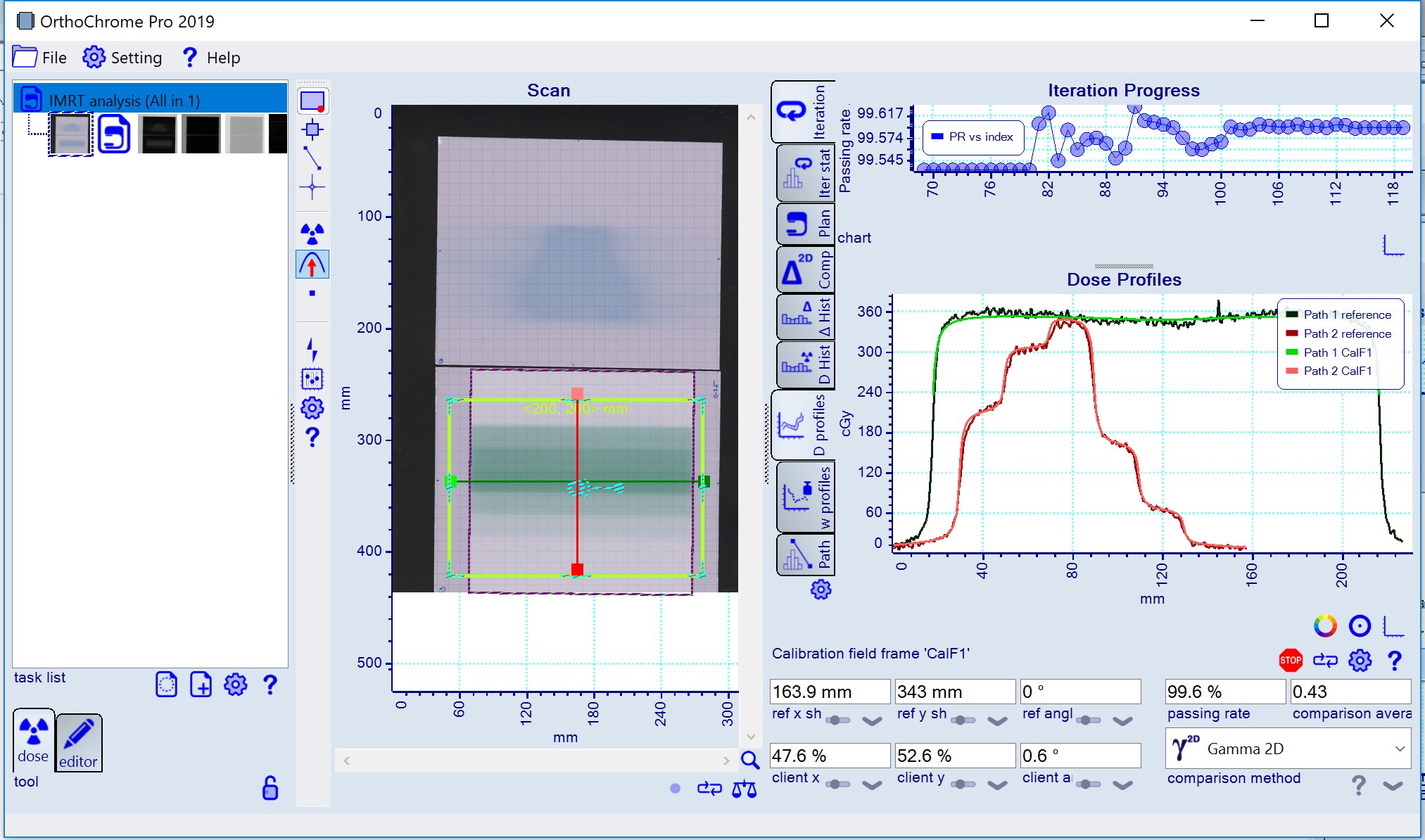
Stop the registration optimization when calibration data and calibration plan agree well enough by pressing the
 button.
Important: After calibration registration is optimized, recalibrate and update dose data by pressing the
button.
Important: After calibration registration is optimized, recalibrate and update dose data by pressing the
 update button. Otherwise the improved calibration registration will Not be reflected by the calibration and dose map data!
update button. Otherwise the improved calibration registration will Not be reflected by the calibration and dose map data!
|
|
6. Comparison area and treatment plan assignment
Select frame tool
 and draw frame around the treatment field area as shown below.
and draw frame around the treatment field area as shown below.
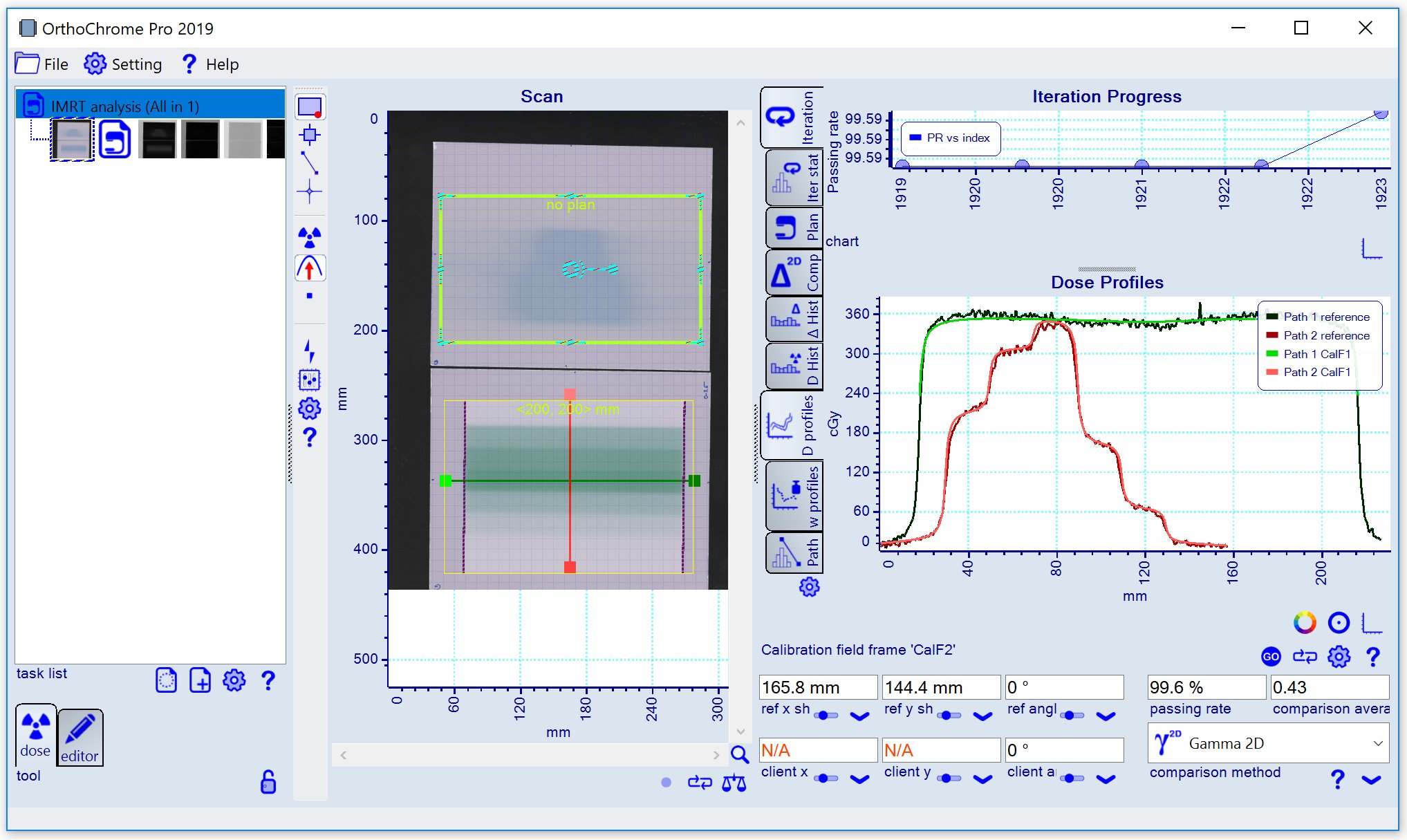
Change the frame type to 'Comparison area', right click inside the frame and select the type as shown below.
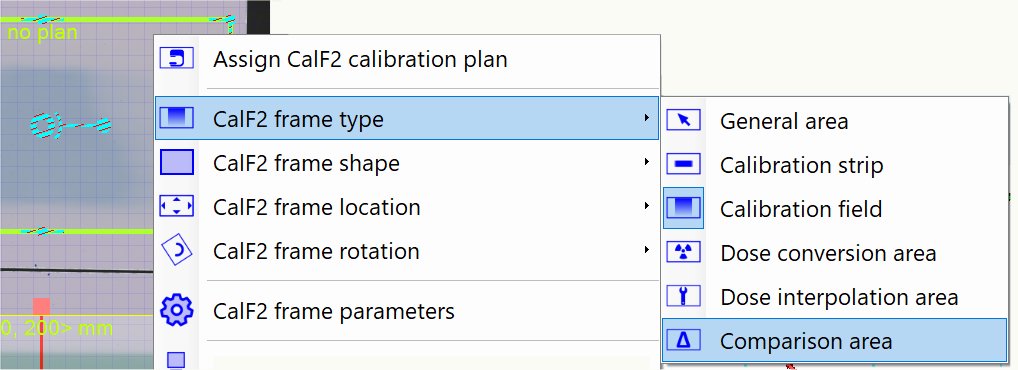 After the frame type is changed, a 'Load file' panel will pop up automatically to load the treatment plan data -
select the file 'Prostate 250 cGy Dose Plane.dcm' (use the filter 'DICOM - dcm (single image)').
The treatment plan can be changed any time by right clicking inside the comparison frame and using 'Assign treatment plan'.
Note: The treatment plan image needs to be rotated by 180° using the 'Bitmap Reader' as shown below.
After the frame type is changed, a 'Load file' panel will pop up automatically to load the treatment plan data -
select the file 'Prostate 250 cGy Dose Plane.dcm' (use the filter 'DICOM - dcm (single image)').
The treatment plan can be changed any time by right clicking inside the comparison frame and using 'Assign treatment plan'.
Note: The treatment plan image needs to be rotated by 180° using the 'Bitmap Reader' as shown below.
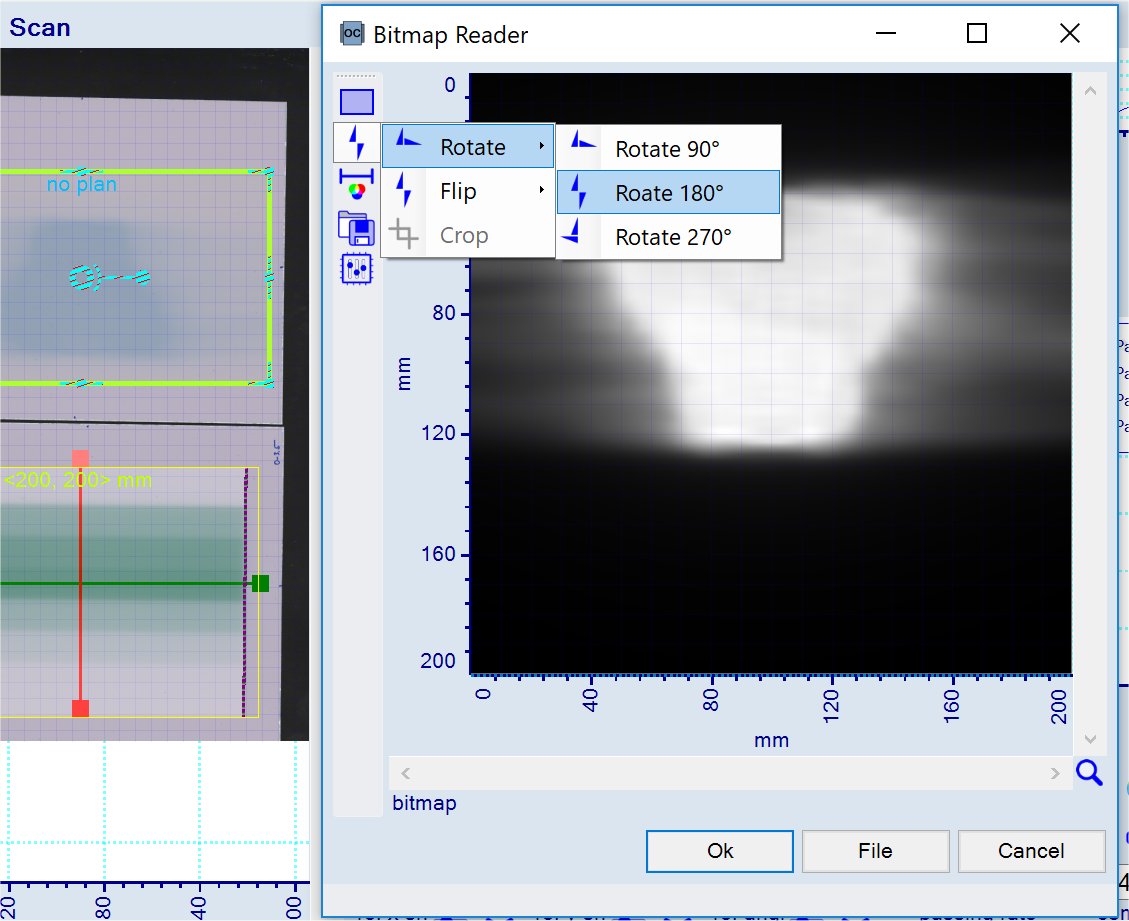 Assign path pattern to comparison frame to profile dose vs plan data, use context menu as shown below.
Assign path pattern to comparison frame to profile dose vs plan data, use context menu as shown below.
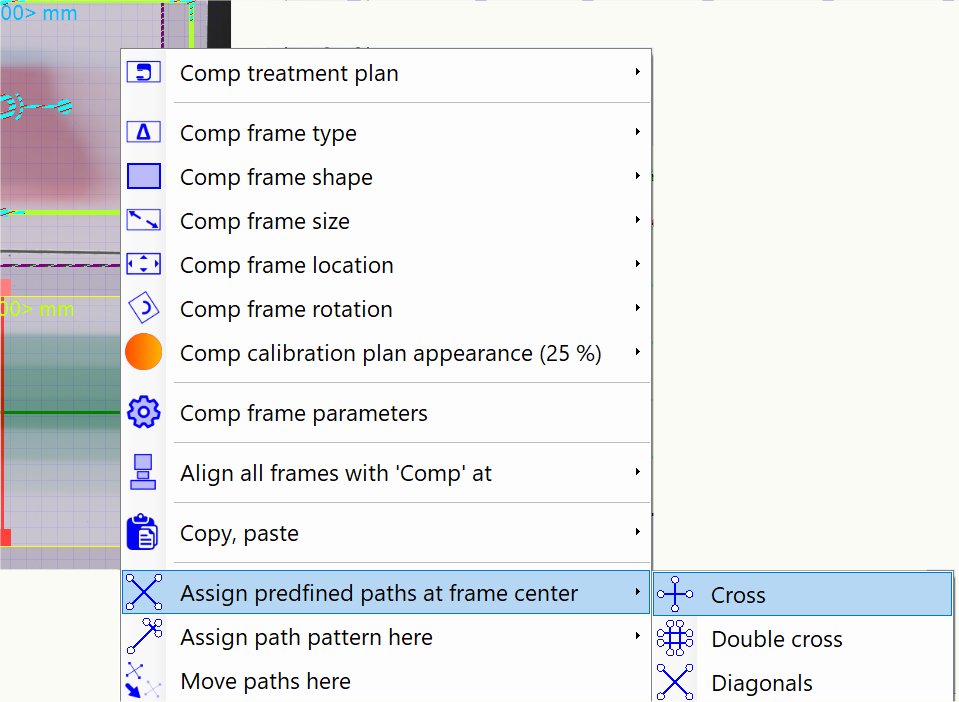 When the paths are assigned, the profiles dose vs treatment plan will look similar as shown below - since the plan registration is Not optimized yet,
there is a noticable profiles offset visible and the passing rate is still low.
When the paths are assigned, the profiles dose vs treatment plan will look similar as shown below - since the plan registration is Not optimized yet,
there is a noticable profiles offset visible and the passing rate is still low.
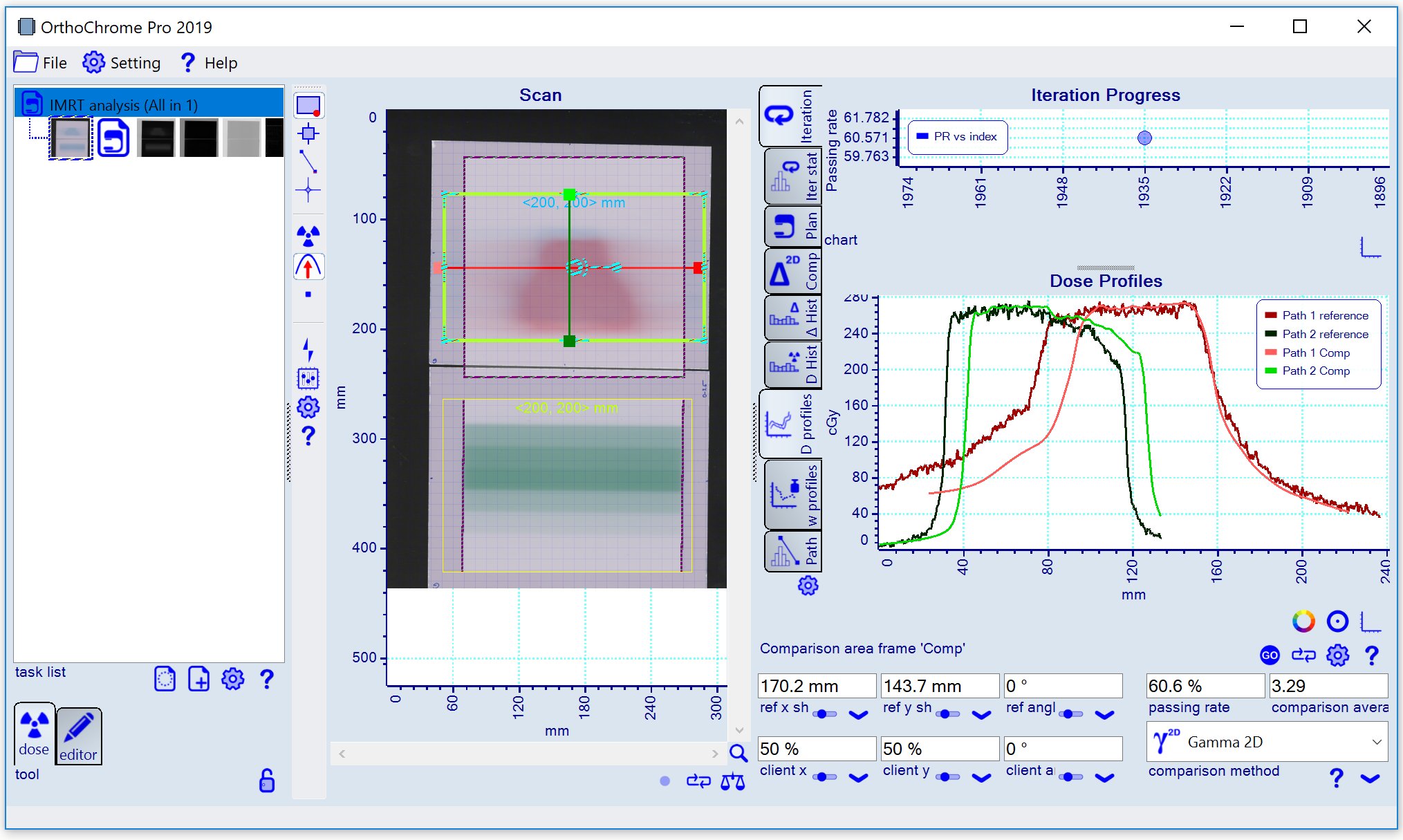
|
|
7. Optimization of treatment plan registration
To start the optimization of the treatment plan registration press the
 button - below OC Pro panel optimizing plan registration.
button - below OC Pro panel optimizing plan registration.
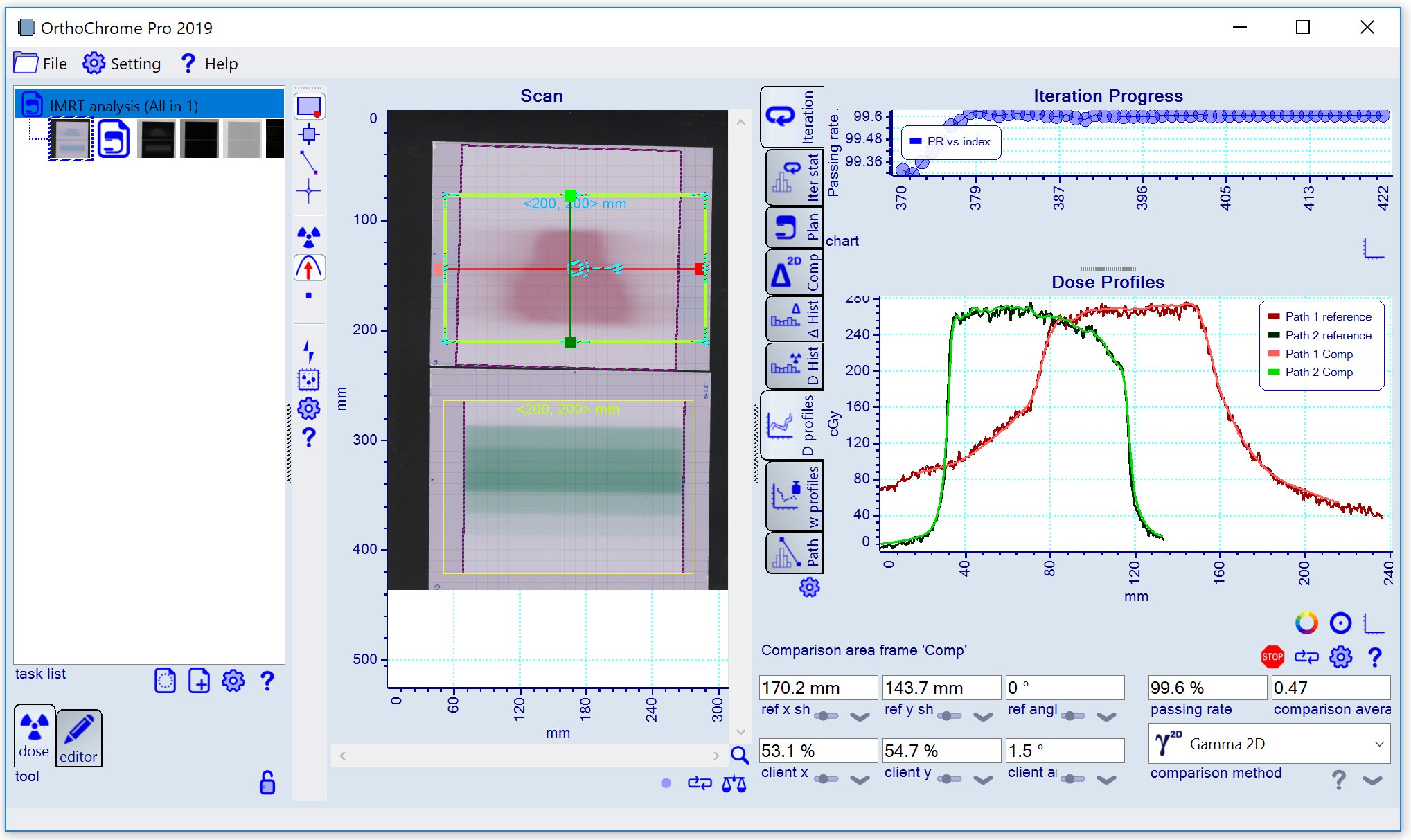
Stop the registration optimization when calibration data and treatment plan agree well enough by pressing the
 button. This completes the treatment analysis process.
A full profile path through both treatment and calibration data (shown below) summerizes the achieved quality of the treatment plan analysis.
button. This completes the treatment analysis process.
A full profile path through both treatment and calibration data (shown below) summerizes the achieved quality of the treatment plan analysis.
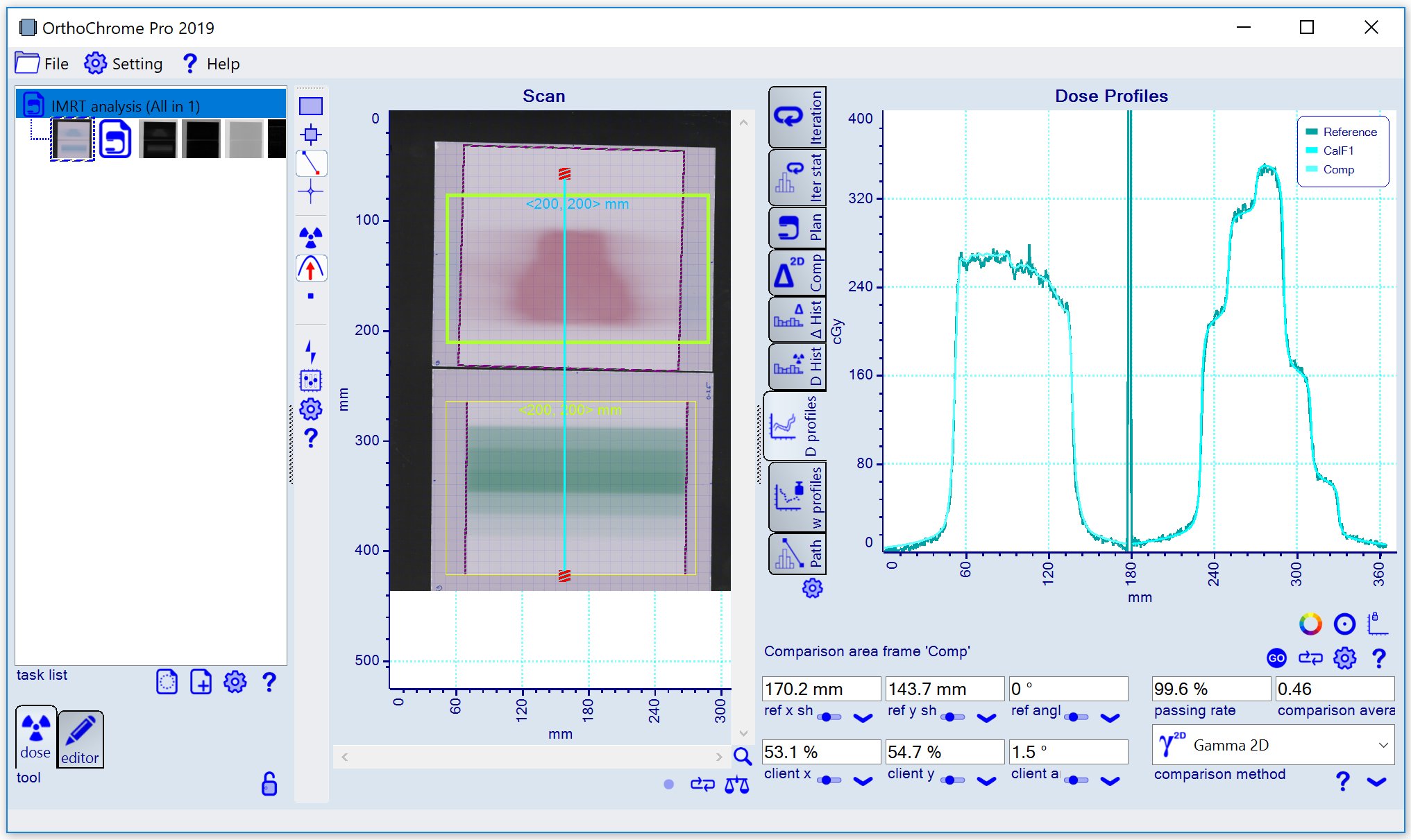
|
-- end of document --





 Add task
Add task
 icon ('Landscape scan') and load bitmap 'Scan_Prostate 250 cGy StepWedge.tif'.
icon ('Landscape scan') and load bitmap 'Scan_Prostate 250 cGy StepWedge.tif'.


 and load the plan data 'Prostate 250 cGy Step Calibration 0-3.5 Gy Dose Plane.dcm' (use the filter 'DICOM - dcm (single image)').
Note: The plan image needs to be rotated by 180° as shown below. Any quadrant adjustment (rotation, flipping), dose range scaling or cropping can be carried out in the 'Bitmap Reader' panel.
and load the plan data 'Prostate 250 cGy Step Calibration 0-3.5 Gy Dose Plane.dcm' (use the filter 'DICOM - dcm (single image)').
Note: The plan image needs to be rotated by 180° as shown below. Any quadrant adjustment (rotation, flipping), dose range scaling or cropping can be carried out in the 'Bitmap Reader' panel.

 underneath the center image. One can recalibrate at any time using the
underneath the center image. One can recalibrate at any time using the
 button.
To profile the calibration data vs calibration plan assign a predefine paths by right clicking inside the calibration frame as shown below.
button.
To profile the calibration data vs calibration plan assign a predefine paths by right clicking inside the calibration frame as shown below.
 Select the 'Dose Profile' tab
Select the 'Dose Profile' tab
 of the chart mosaic to get the display as shown below indicating that the registration of the calibration plan is not perfect yet.
of the chart mosaic to get the display as shown below indicating that the registration of the calibration plan is not perfect yet.




 After the frame type is changed, a 'Load file' panel will pop up automatically to load the treatment plan data -
select the file 'Prostate 250 cGy Dose Plane.dcm' (use the filter 'DICOM - dcm (single image)').
The treatment plan can be changed any time by right clicking inside the comparison frame and using 'Assign treatment plan'.
Note: The treatment plan image needs to be rotated by 180° using the 'Bitmap Reader' as shown below.
After the frame type is changed, a 'Load file' panel will pop up automatically to load the treatment plan data -
select the file 'Prostate 250 cGy Dose Plane.dcm' (use the filter 'DICOM - dcm (single image)').
The treatment plan can be changed any time by right clicking inside the comparison frame and using 'Assign treatment plan'.
Note: The treatment plan image needs to be rotated by 180° using the 'Bitmap Reader' as shown below.
 Assign path pattern to comparison frame to profile dose vs plan data, use context menu as shown below.
Assign path pattern to comparison frame to profile dose vs plan data, use context menu as shown below.
 When the paths are assigned, the profiles dose vs treatment plan will look similar as shown below - since the plan registration is Not optimized yet,
there is a noticable profiles offset visible and the passing rate is still low.
When the paths are assigned, the profiles dose vs treatment plan will look similar as shown below - since the plan registration is Not optimized yet,
there is a noticable profiles offset visible and the passing rate is still low.


